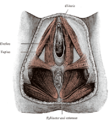Anus
Editing of this article by new or unregistered users is currently disabled. See the protection policy and protection log for more details. If you cannot edit this article and you wish to make a change, you can submit an edit request, discuss changes on the talk page, request unprotection, log in, or create an account. |
In anatomy, the anus (from Latin ānus "ring, anus") is the external opening of the rectum. Closure is controlled by sphincter muscles. Feces are expelled from the body through the anus during the act of defecation, which is the primary function of the anus. Most animals — from simple worms to elephants and humans — have a tubular gut, with a mouth at one end and an anus at the other.
The anus is often considered a taboo part of the body, and is known by a large number of usually vulgar slang terms.
Structure
The human anus is situated between the buttocks, posterior to the perineum. It has two anal sphincters, one internal, the other external. These hold the anus closed until time to defecate. One sphincter consists of smooth muscle and its action is involuntary; the other consists of striated muscle and its action is voluntary. In many animals, the anus is surrounded by anal sacs.
Role in defecation
When the rectum is full, the increase in intrarectal pressure forces the walls of the anal canal apart allowing the fecal matter to enter the canal. The rectum shortens as material is forced into the anal canal and peristaltic waves propel the feces out of the rectum. The internal and external sphincters of the anus allow the feces to be passed by muscles pulling the anus up over the exiting feces.
To prevent diseases of the anus and to promote general hygiene, humans often clean the anus after emptying the bowels. A wash with a bidet or a wiping with toilet paper are often used to clear the anus of fecal matter.
Role in sexuality
The anus has a relatively high concentration of nerve endings and is an erogenous zone. Sigmund Freud's theory of psychosexual development, for example, described an anal stage, hypothesizing that toddlers derive pleasure from retaining and expelling feces. This is the source of the term "anal" and the derived, derogatory vulgarism "anal-retentive."
Anal intercourse can be pleasurable for both the insertive partner and the receptive partner. For the receptive partner, pleasure from anal intercourse is also thought to be related to the shared wall between the rectum and the vagina (for females) as well as the G-spot or prostate (for males). For the insertive partner, the tightness of the anus is often said to be a source of pleasure in penetrative anal sex.
Anal intercourse, sometimes referred to as sodomy or buggery, is a human sexual activity, but is considered taboo in a number of moral systems, and it has been, and in some jurisdictions continues to be, a crime carrying severe punishment.
Anal sexual activity need not include penetration. The anus also plays an important role in facesitting, coprophilia and anilingus.
Anal stretching can stimulate the nerves around the anus and can be considered pleasurable. Care must be taken to maintain elasticity.
Puberty
During puberty, as testosterone triggers androgenic hair growth on the body, pubic hair begins to appear around the anus. Although initially sparse, it fills out by the end of puberty, if not earlier.
Health
Hygiene is important for good anal health and anal sex. Washing with a mild soap and water will keep the anus clean. Harsh soaps or wiping vigorously with toilet paper can irritate the skin around the anus, making it itchy or sore. Pinworms are sometimes the source of anal itching.
Care should be taken not to strip the anus of natural oils that keep the skin around the opening supple and elastic.
Penetration with a penis or sex toy can irritate or tear the inside of the anus. Lubrication is often recommended to ease penetration. The risk of injury to the anal sphincter should be a concern, which can lead on to lack of control of defecation and fecal incontinence. Similarly if the anus is torn, this can occasionally cause a fistula formation which can not only cause fecal leaking, but also can be very difficult to treat.
Kegel exercises can improve the tone of the outer sphincter muscle.
Cosmetics
Shaving, trimming, depilatory, or Brazilian waxing can clear the perineum of hair.
Anal bleaching is a process which phenomenon where the perineum, which darkens over the years,[citation needed] is lightened for a more youthful appearance.
Anal piercing is among the more extreme piercings and usually interferes with the function of the anus.
Pathology
Anal cancer, abscess, warts, fistula, anal fissure, itching and hemorrhoids are among the diseases of the anus that benefit from medical intervention. Birth defects of the anus include stenosis and imperforation. The anus is also a frequent site of sexually transmitted infections. Damaged anal sphincter (patulous anus in more severe cases) — caused by careless surgery in the perineal region or by rough/abrupt penetration in anal sex — can lead to flatus and/or fecal incontinence, chronic constipation and, ultimately, megacolon.
In psychology the Freudian term anal fixation is used.
Additional images
-
Female external genitalia.
-
Muscles of male perineum.
-
Muscles of the female perineum.
See also
- Anal masturbation
- Anal sex
- Anal stage (Freudian psychosexual stage)
- Arse
- Cloaca
- Digestive system
- Flatulence
- Goatse.cx
External links
- Patient Queries - Anus Patient Queries answered by Physicians and Gastroenterologists pertaining to problems of the Anus


